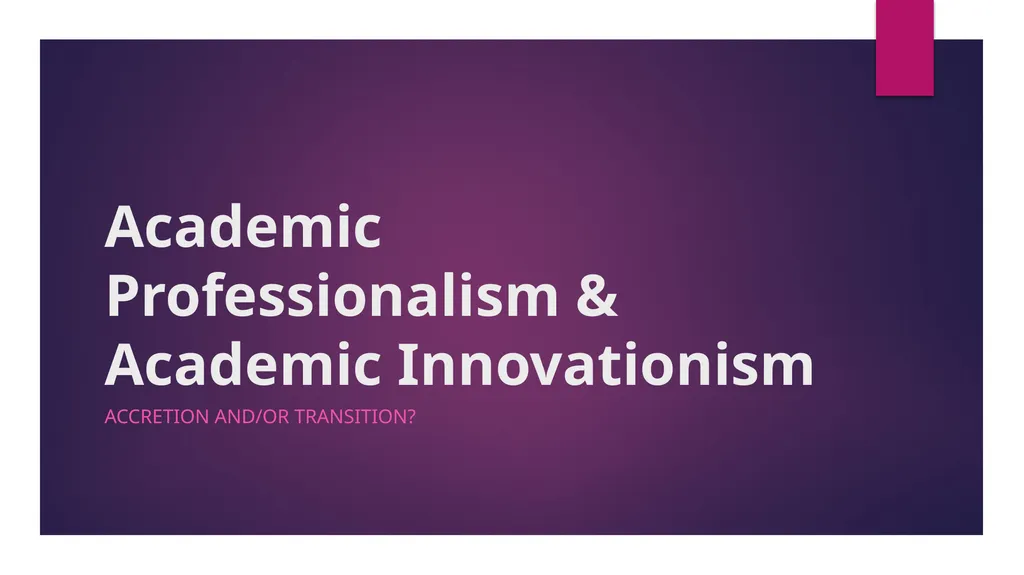Academic Professionalism & Academic Innovationism
Author : test | Published Date : 2025-05-19
Description: Academic Professionalism Academic Innovationism Accretion andor Transition Growth of Scientific Research Output of Top 188 US Universities 19802010 1980 RD Expenditures all sources 44 billion Web of Science Publications
Presentation Embed Code
Download Presentation
Download
Presentation The PPT/PDF document
"Academic Professionalism & Academic Innovationism" is the property of its rightful owner.
Permission is granted to download and print the materials on this website for personal, non-commercial use only,
and to display it on your personal computer provided you do not modify the materials and that you retain all
copyright notices contained in the materials. By downloading content from our website, you accept the terms of
this agreement.
Transcript:Academic Professionalism & Academic Innovationism:
Academic Professionalism & Academic Innovationism Accretion and/or Transition? Growth of Scientific Research Output of Top 188 U.S. Universities, 1980-2010 1980 R&D Expenditures (all sources): $4.4 billion Web of Science Publications: 191,000 Web of Science Citations: 4.3 million (1980 articles measured in 2015) 2010 R&D Expenditures (all sources): $46.9 billion Web of Science Publications: 555,000 Web of Science Citations: 10.7 million (2005 articles measured in 2015) Growth of U.S. Adult Population with Postsecondary Degrees, 1987-2010 As of 2015: Bachelor’s Degrees: 68.9 m. (32.5% of population age 25+) Advanced Degrees: 25.5 m. (12% of population age 25+) First Professional/Doctorate Degrees: 10.1 m. (5% of population age 25+) Source: National Center for Education Statistics (2015) Historical Context Context Key Legislation Explanations Context of Competitiveness Policy R. Solow (1956, 1957) comparative studies of economic growth: 87% residual after primary factors of production (land, labor, and capital) taken into account. E. Denison (1985): ~66% of residual due to technological innovation; ~33% due to improvements in human capital. U.S. competitive situation in 1970s: After-tax profits 10% in 1965; 4.5% in 1975. Productivity gains plateauing at 1% per year. Japanese industry surging in steel, automobiles, machine tools, and consumer electronics. Boyer/Cohen discovery of gene splicing technology (1973) creates an entirely new industry in late 1970s and early 1980s from academic science. Key Legislation of the 1980s Bayh-Dole Act of 1980: Reduces restrictions on university patenting of discoveries made with federal funds and encourages licensing of patented discoveries to private firms. Stevenson-Wydler Act of 1980: Required federal laboratories to actively participate in technology transfer activities. National Cooperative Research Act of 1984: Provided special anti-trust status to R&D joint ventures and encouraged broad government-industry-university cooperative funding. Actors, Ideologies, & Policy Windows The corporate influence argument: S. Slaughter and G.R. Rhoades (1996) The state interest/ideological convergence argument: E.P. Berman (2012) The policy window argument: J. Kingdon (1984) Mechanisms Patenting/Licensing University-Industry Research Centers 50 State Mobilization Grand Challenges Interdisciplinary Cluster Hiring Licenses and Licensing Income Licenses Executed Licensing Income (in millions) University-Industry Research Centers 1980: first NSF funding of University-Industry Research Centers. Cohen, Florida, and Goe (1990): Estimate of 1,100 UIRCs and $1 b. in external support by 1989. Notable examples: Cal Tech’s Silicon Structures Program, MIT’s Polymer Processing Center, Microelectronics Center of North Carolina (MCNC), Minnesota Microelectronics and Information Sciences (MEIS). About 70% of industry funding for university research channeled through UIRCs. Mobilization in the 50 States: Examples New York














